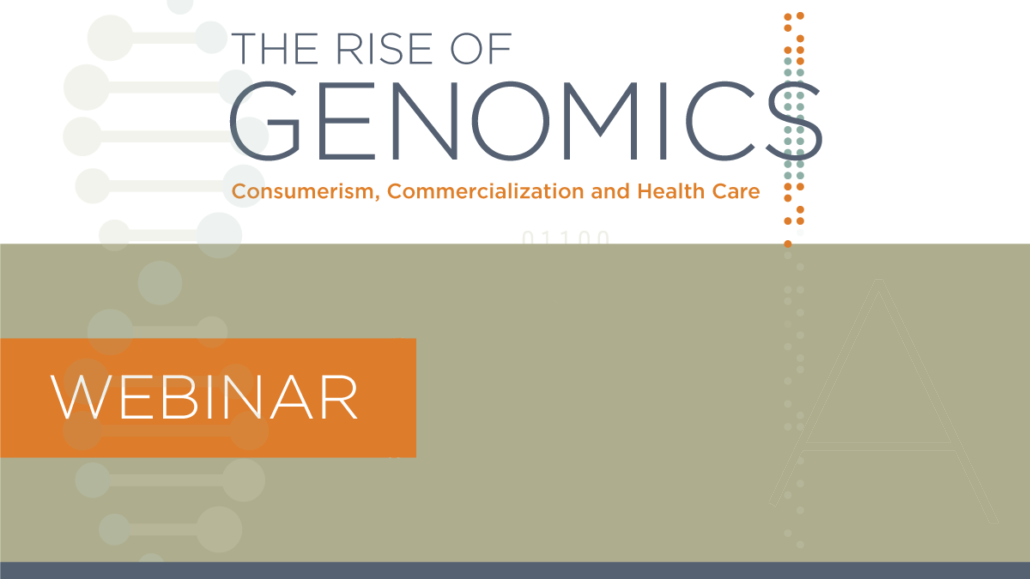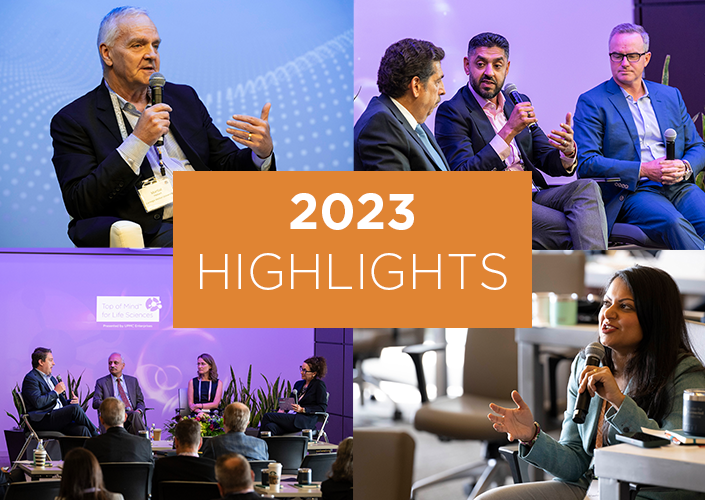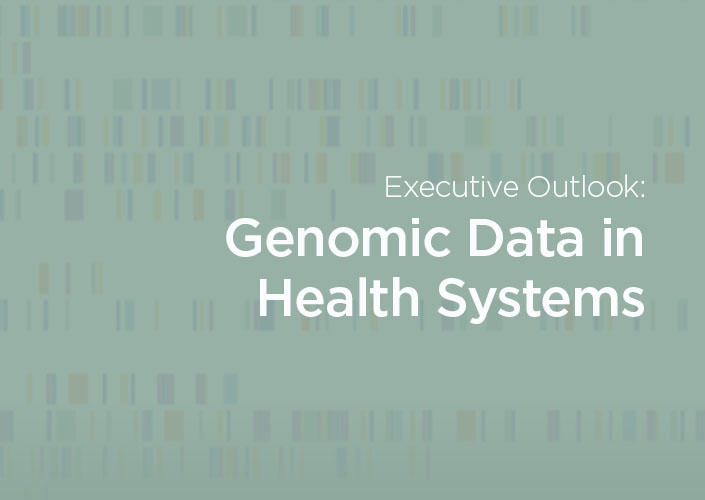How do we accelerate precision medicine into the clinical practice? Can genomic data be integrated into electronic medical record systems? Is the genomics industry looking to blockchain as a privacy and security solution?
These are just a few examples of the many great questions posed by viewers of the Center for Connected Medicine’s “The Rise of Genomics” webinar, which featured a panel of experts discussing the ways genetic testing is driving change in health care.
The CCM collected answers to a dozen audience questions about genetic testing from the expert panelists:
- Jill Hagenkord, MD, Chief Medical Officer, Color
- Mylynda B. Massart, MD, PhD, Co-Investigator, All of Us Pennsylvania
- Houman Modarres, Senior Director of IP Networks, Nokia
- Martin Reese, PhD, Founder and CEO, Fabric Genomics
Below are the questions and answers.
When Dr. Hagenkord mentions that the clinical criteria are too stringent, what criteria is she referring too? Also, what is the data that she is referencing that shows that many are missed by the current criteria?
Payers will only pay for inherited disease testing if there is a significant personal or family history of a specific genetic condition. For the Centers for Disease Control and Prevention Tier 1 genetic conditions, studies have been done where they tested everyone in the population (rather than just those that met criteria). These studies have shown the current coverage criteria would disqualify 20-50 percent of mutation carriers from getting tested.
Where do you see pharmacogenetic/PGx testing playing a role in the overall genomic ecosystem?
Pharmacogenomics involves the investigation of the effects of genetic variation on drug response with the aim of offering clinical decision support to improve the benefit-risk profile of prescribed medications. PGx has been around for over 30 years, but is rarely ordered or utilize. However, consumer genomics enables PGx to arrive in doctors’ offices for “free” in real time, and doctors may be more likely to consider the information if it is there at the right time.
Can data from a testing kit can be integrated with the electronic medical record?
Typically, when a diagnostic test is performed, test performance statistics and design details for the genomic test are included in the test description field. These statistics and details can include items such as: number of genes, names of genes tested for, sequencing platform, analysis pipeline version, as well as testing kit information. The amount of detailed test description pushed into the EMR typically depends on the provider’s customization of the EMR.
What is the industry’s dependency on different brand sequencers, and what is the role of file formats extracted and databases for genomics data processing?
The majority of clinical next generation sequencing (NGS) has been done on the suite of Illumina sequencers from the MiSeq, HiSeq to the NovaSeq, followed by IonTorrent sequencing on the Proton platform (predominantly in oncology sequencing). Some of these machines are FDA approved. Sequencing machines are installed with a CLIA laboratory, and each machine is individually validated by the CLIA laboratory for their laboratory developed test (LDT). New sequencers such as BGISeq and Oxford Nanopore sequencers are slowly coming online as well.
With respect to file formats, various standard file formats have been developed from the FASTQ-format (raw sequence reads), to BAM-format (aligned read sequences) and to the variant call format (VCF-format). With respect to databases for genomics, there are over 90 databases and algorithmic sources used for interpreting genetic variants. These databases and sources grow daily. Standardization and quality are an unsolved problem in the industry. Some software provider companies tackle these challenges by providing best-practices suggestions to CLIA laboratory customers.
What if patients don’t want their genome sequenced?
Patients are partners in their own health care, and no patient should be forced to take a test that he or she doesn’t want to take. However, as precision medicine and genomics become more valuable, common and integrated into health care best practices, physicians will have greater expertise in outlining its benefits.
What is going to be the value of large whole genome shotgun (WGS) databases? Will having a base of the genomes of 1 million people be an economic asset?
It is not clear that the All of Us research project will use a shotgun sequencing approach. The intent will likely be to sequence a subset of the million participants and to balance the economic gain from this knowledge versus the cost. These are all discussions still currently in progress.
The economic value of WGS remains to be proven. Health economic studies (with respect to sequencing data and the impact on preventative health), reduced harm, and quality-adjusted life years will be some areas of potential research that will be appropriate within the All of Us study.
If a genetic test suggests a genetic predisposition to a disease, and an individual informs their physician of this information, how might this impact his or her insurance?
The Genetic Information Nondiscrimination Act (GINA) bars health insurance companies from denying coverage to those with a gene mutation. However, GINA was passed 10 years ago, and some believe it should be reviewed considering rapid changes and growth in the genomics industry.
How do we accelerate precision medicine into everyday practice?
Development of precision medicine education programs is imperative to improve the confidence of providers and accelerate precision medicine integration. In addition, health systems need to develop robust support and ongoing education for both providers and patients as the integration of precision medicine for clinical decision-making support becomes more prevalent.
Does physician resistance occur because doctors don’t believe in the efficacy of the genetic tests, or are they worried about potential liability insofar as tests revealing something they should have caught?
Primary care physicians have historically been cautious of genomics due to lack of education and confidence in the field. Physician training is one way to help physicians embrace the rise of genomics. For example, Test2Learn is a course being developed at the University of Pittsburgh that will provide primary care physicians with the ability to advance their comfort, knowledge and skills in the field of precision medicine and genomics.
What’s driving breaches in genomics data? Financial gain? Creating chaos?
In the case of most health care related data breaches, cyberattacks are executed with the intent of soliciting financial gain through ransomware or the sale of stolen data on the dark web. Attacks with the intention to engage chaos or protest are relatively less common.
Is DevOps (or DevSecOps) almost a requirement for the IT environment to be stable and nimble enough to support the needs and demands genomics will place on IT?
The appeal of the DevSecOps mantra and mode of operations is the agility it delivers to the IT environment. It is successful in highly dynamic environments where code and configurations can change over a dozen times weekly. It is unlikely to be a requirement for the support of genomics workloads or in most health care IT environments. Stability and security of the infrastructure in support of the application is a far more critical consideration, as the application environment is not prone to daily churn. That said, a good DevOps environment never hurts!
Is the industry looking at blockchain technology as a solution to genomic data privacy and security challenges?
Yes. Blockchain technology is already being used by some genomics companies to protect genomic data. The appeal is that blockchain can ensure control and security without centralization.



